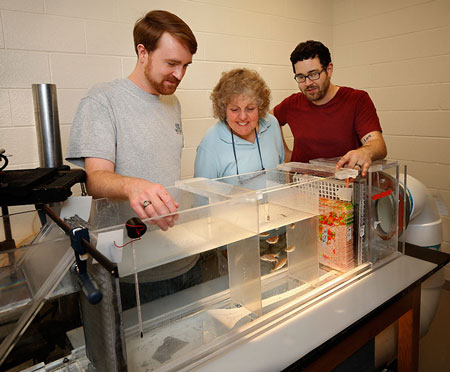| Jun 13, 2013 |
Using fish to design better underwater robots
|
|
(Nanowerk News) What does the Office of Naval Research (ONR) want with a bunch of fish? To help design a better Autonomous Underwater Vehicle (AUV), of course. Dr. Sheryl Coombs, a professor in the Department of Biological Sciences at Bowling Green State University, received a grant to help do just that.
|
|
As part of a decade-long effort by the U.S. Department of Defense to encourage collaboration between biologists and engineers, several programs have been designed, two of which have involved Coombs. The first began in 2005, and was a large, multi-university collaboration supported by the Defense Advanced Research Projects Agency. Named BioSenSe (Biological Sensory Structure Emulation), the program was “designed around the concept of understanding biological sensory structures through advanced characterization and emulating, or transferring, this knowledge to the creation of superior synthetic sensors.” Or, as Coombs simplifies, “the goal was to harness bio-inspired sensing technologies and capabilities for defense applications.”
|
 |
| L-R John Elder, Masters student in Biology, studies fish behavior in a flow tank with Biological Science professor Sheryl Coombs and Masters student Joseph Bak-Coleman
|
|
Coombs was then invited to join a team of engineers at the University of Maryland to explore various collaborative efforts that ultimately led to a three-year grant ($227,227 of which supports her work at BGSU) from the ONR titled “Bio-Inspired Flow Sensing and Control for Autonomous Underwater Vehicles.” The grant represents a collaboration between Bowling Green State University, the University of Maryland and Michigan State University. The team includes Coombs and three engineers: Dr. Derek Paley, principal investigator on the engineering component of the grant and director of the Collective Dynamics and Control Laboratory, and Dr. James Sean Humbert, director of the Autonomous Vehicle Lab. Both Paley and Humbert are associate professors in the Department of Aerospace Engineering at Maryland. The third member of the team is Dr. Xiaobo Tan, director of the Smart Microsystems Laboratory and an associate professor in the Department of Electrical and Computer Engineering at Michigan State.
|
|
For the past two years the team has been trying to figure out how specific sensory capabilities in fish can be transferred to state-of-the-art sensory technology that can be applied to creating superior sensors for military and civilian applications with AUVs.
|
|
“The specific research objective is to apply tools from different scientific disciplines, including sensory biology, neuroethology, information theory, materials science and control theory, to determine how fish use flow information in rheotactic (movement of an organism in response to a current of water) and station-holding behaviors,” Coombs said. “We then want to apply what is learned to engineering applications – how to use artificial flow sensors for feedback control of autonomous vehicles in the underwater environment.”
|
|
The project has two basic parts, a biological component and an engineering component. Coombs will lead the biological component.
|
|
Coombs and her students are conducting research at BGSU to try to understand the role of hydrodynamic sensing in fish behavior.
|
|
“Hydrodynamic sensing refers to the ability of fish to ‘sense’ flow along the skin surface using a sensory system known as the lateral line,” Coombs explained. She is one of the few experts in the world on this flow-sensing system. “Fish use flow information in a variety of behavioral contexts. In this study, we are investigating the role of the lateral line in the ability of fish to maintain an upstream (rheotaxis) and a streamwise position (station-holding) in the face of strong currents.”
|
|
Coombs and her team have found that rheotaxis is a very “robust” behavior.
|
|
“Fish can use multiple senses to orient upstream and are able to compensate for the loss of one or more senses,” Coombs said. “The challenge is to determine how both visual and non-visual sensory systems, in particular the lateral line, contribute to the overall behavior in different contexts.”
|
|
The second, three-part engineering component is the translation of biological sensors and control systems for fish behavior into the design of a closed-loop control system for an autonomous underwater vehicle. The engineering team will: (1) construct mathematical models for the assimilation of hydrodynamic signals into a feedback control system (Humbert), (2) fabricate bio-inspired flow-sensor arrays using electroactive polymers (Tan), and (3) design and demonstrate a prototype robotic system that uses closed-loop control with artificial flow-sensor arrays to implement bio-inspired behavior (Paley).
|
|
Student collaboration has proven to be productive. Undergraduate and graduate students are involved in researching, designing and conducting behavioral experiments, and analyzing and presenting the experimental results. Students also have been able to participate in summer exchanges with the University of Maryland, in which students from Paley’s lab visit the BGSU lab, and BGSU students visit the East Coast lab.
|
|
“It’s a mutually beneficial arrangement,” Coombs commented. “Engineering students are exposed to the behavioral experiments that are done here with live fish, and the biology students at BGSU get an opportunity to see what engineers can accomplish with robots and how they approach and solve engineering problems.”
|
|
“I really enjoy the collaborative nature of this project,” said Joe Bak-Coleman, a graduate student studying at BGSU with Coombs. “It has been fun working with engineers and learning how to communicate with people from very different academic backgrounds.” Bak-Coleman said he feels lucky to have been funded through the grant. “This grant has produced two publications (one submitted and one in write-up), which is a huge thing for a master’s student, and will make me more competitive when applying for Ph.D. programs.” He has been able to present this work at several conferences in Indiana, Maryland and Germany.
|

